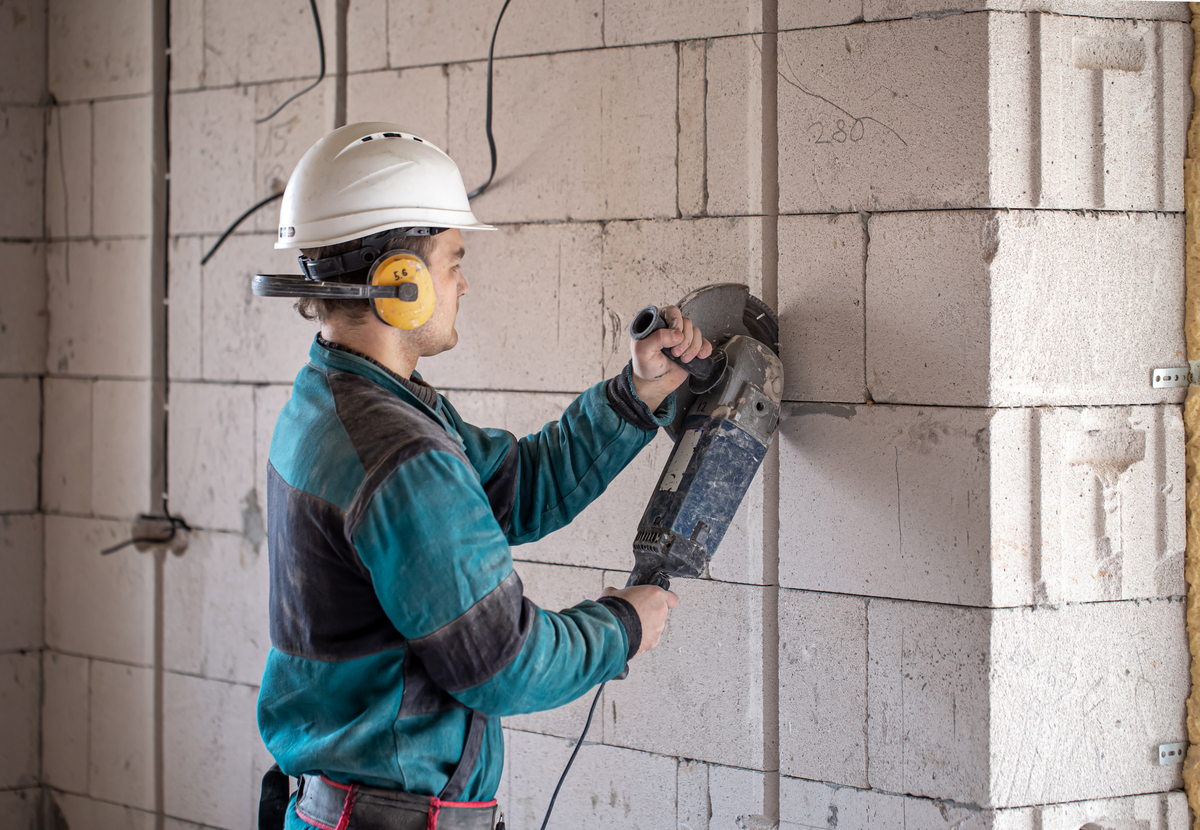In the intricate tapestry of the construction industry, the specter of rework looms large, silently draining resources, timelines, and project quality. Statistics reveal a staggering reality: an estimated 12% to 15% of total construction costs are attributed to rework, constituting billions of dollars annually in the United States alone.
Construction rework, defined as the need for repetitive or corrective actions due to errors, miscommunications, or design changes, represents a pervasive challenge in project management. This multifaceted issue impacts every facet of construction, from towering infrastructure projects to intricate residential developments. The Construction Industry Institute reports that rework can consume up to 20% of total project time, causing substantial delays and, consequently, financial setbacks.
The causes of rework are as diverse as the projects themselves. From design errors and material discrepancies to poor communication and regulatory compliance issues, each factor contributes to the intricate web of rework that affects construction endeavors worldwide.
However, beyond the daunting statistics and myriad challenges lies an opportunity to delve into the depths of understanding, strategizing, and implementing measures to mitigate this pervasive issue. The landscape of construction rework is evolving, driven by technological advancements, innovative methodologies, and a renewed emphasis on collaboration and sustainability.
This introduction sets the stage for a deeper exploration of construction rework, unveiling its causes, far-reaching impacts, and the dynamic strategies poised to reshape the industry’s approach to this critical issue.
Table of Contents
Understanding Construction Rework
Understanding construction rework is essential for anyone in the construction industry, as it directly impacts project timelines, budgets, and overall quality. Here are some key points to grasp:
Definition of Construction Rework
Construction rework refers to the need for repetitive or corrective actions in a construction project due to various reasons such as errors, omissions, design changes, material issues, or inadequate communication. It involves redoing portions of work already completed or modifying existing work to meet new specifications.
Types and Causes of Rework
- Design Errors: Inaccuracies or flaws in the initial project plans or blueprints.
- Material Issues: Defective or incorrect materials delivered to the site.
- Change Orders: Alterations requested after the project has started, leading to modifications in the original plan.
- Poor Communication: Misunderstandings among stakeholders lead to incorrect execution.
- Quality Control Failures: Insufficient checks and balances resulting in subpar work.
Design errors encompass inaccuracies or flaws embedded within the initial project plans or blueprints, potentially leading to deviations from the intended outcome. Material issues arise when defective or incorrect materials are supplied to the construction site, hindering progress and quality. Change orders, requested after project commencement, necessitate modifications to the original plan, impacting timelines and resources.
Poor communication among stakeholders breeds misunderstandings, causing erroneous execution and disruptions. Quality control failures signify inadequate checks and balances, resulting in subpar workmanship that falls short of specified standards. These challenges, spanning from design discrepancies to communication breakdowns and material defects, pose significant hurdles in project execution, demanding vigilant oversight and effective resolution strategies to ensure successful completion within established parameters.
Suggested article to read: 11 Innovative Construction Materials; 2024 Review
Impact of Rework on Construction Projects
- Cost Overruns: Rework significantly inflates project costs due to additional labor, materials, and extended timelines.
- Time Delays: Each instance of construction rework extends project schedules, affecting deadlines and potentially incurring penalties.
- Quality Compromise: Frequent rework can compromise the overall quality of the project, affecting its functionality and longevity.
- Reputation Damage: Clients may lose trust in contractors or construction firms due to excessive rework, impacting future contracts and partnerships.
Cost Overruns occur when the need for construction rework inflates project expenses, leading to increased labor, material costs, and prolonged timelines. These overruns directly impact the project’s budget, often surpassing the initially estimated costs.
Time Delays are a natural consequence of rework, as each instance extends project schedules, affecting deadlines and potentially resulting in penalties for missing established milestones. These delays disrupt the project’s flow and can have cascading effects on interconnected tasks.
Quality Compromise becomes a pressing concern with frequent construction rework, undermining the project’s overall quality. This compromise can detrimentally impact its functionality and durability, posing long-term implications for its effectiveness.
Reputation Damage is a significant consequence, as clients may lose trust in contractors or construction firms due to excessive rework. This erosion of trust can negatively impact future contracts and partnerships, affecting the firm’s business prospects and growth.
Strategies to Mitigate Rework
- Prevention through Planning: Thorough planning and design reviews to minimize errors upfront.
- Improved Communication: Enhance collaboration among stakeholders to ensure everyone is on the same page.
- Technology Integration: Utilize Building Information Modeling (BIM), drones, and AI for accurate project visualization and early detection of issues.
- Quality Assurance Programs: Implement stringent quality control measures at every stage of construction.
Prevention through Planning stands as the foundational cornerstone, emphasizing the significance of comprehensive planning and meticulous design reviews. This approach aims to curtail errors right from the outset, fostering a smoother project trajectory.
Improved Communication serves as the vital conduit for seamless collaboration among stakeholders, fostering a cohesive understanding and alignment among all involved parties.
Technology Integration marks a pivotal stride, leveraging Building Information Modeling (BIM), drones, and AI to yield precise project visualization and the early identification of potential issues, facilitating proactive problem-solving.
Further fortification comes through Quality Assurance Programs, which deploy rigorous quality control measures at each construction stage, ensuring adherence to exacting standards and bolstering the project’s overall integrity. These multifaceted strategies coalesce to create a fortified framework, enriching the construction process and elevating its efficiency and reliability.
Importance of Addressing Rework
Understanding and actively managing rework is crucial for maintaining project profitability, meeting client expectations, and ensuring the sustainability of construction businesses. By addressing construction rework effectively, construction firms can improve efficiency, reduce costs, and enhance their reputation within the industry.
Overall, comprehending the causes, impacts, and strategies to mitigate construction rework is fundamental for successful project management and sustainable growth in the construction sector.

Current Trends in Construction Rework (2024)
In 2024, the construction industry continues to evolve, adopting various trends and advancements aimed at minimizing construction rework. Some of the current trends in construction rework management include:
1. Technology Integration
- AI and Machine Learning: Utilizing AI algorithms to predict potential errors and optimize project planning.
- Augmented Reality (AR) and Virtual Reality (VR): Enhancing visualization and design accuracy, allowing stakeholders to identify issues before construction begins.
- Drones and UAVs: Conducting site surveys, monitoring progress, and inspecting hard-to-reach areas, reducing errors and rework.
2. Building Information Modeling (BIM) Enhancements
- Advanced BIM Software: Integration of BIM with other technologies like IoT for real-time project monitoring, clash detection, and coordination among different trades, reducing rework arising from clashes or coordination issues.
- BIM for Facility Management: Transitioning from construction to facility management, ensuring accurate data handover and reducing post-construction rework.
3. Prefabrication and Modular Construction
- Off-Site Construction: Prefabrication of building components in controlled environments minimizes errors and waste, leading to reduced on-site construction rework.
- Modularization: Using standardized modules to streamline construction processes and minimize design discrepancies.
4. Enhanced Collaboration and Communication
- Cloud-Based Collaboration Tools: Facilitating real-time communication among stakeholders, reducing misinterpretations and errors.
- Integrated Project Delivery (IPD): Collaborative approach involving all key stakeholders from the outset, enhancing coordination and reducing rework due to misalignment.
5. Sustainability and Resilience
- Green Building Practices: Adhering to sustainable construction practices reduces the need for rework related to compliance or retrofitting for environmental standards.
- Resilient Design: Implementing designs that account for climate change and natural disasters to minimize construction rework due to unexpected events.
6. Quality Control and Risk Management
- Advanced Analytics: Utilizing data analytics to predict and proactively manage potential risks, minimizing rework caused by unforeseen issues.
- Continuous Improvement: Emphasizing a culture of quality and continuous improvement to address construction rework root causes systematically.
7. Regulations and Compliance
- Digital Permitting and Compliance Tools: Streamlining regulatory processes, reducing compliance errors, and avoiding rework due to regulatory issues.
8. Skill Development and Training
- Upskilling Workforce: Providing training on new technologies and best practices to reduce human errors leading to construction rework.
These trends collectively aim to enhance project efficiency, reduce rework, and improve overall project outcomes in the dynamic landscape of the construction industry in 2024.
Impact of Rework on Construction Projects
The impact of rework on construction projects is multifaceted, affecting various aspects of the project’s success, including timelines, budgets, quality, and stakeholder relationships. Here’s a breakdown of its impact:
1. Cost Implications
- Increased Expenses: Rework significantly inflates project costs due to additional labor, materials, and equipment required to rectify errors.
- Budget Overruns: Unforeseen construction rework eats into the allocated budget, leading to financial strain for the project stakeholders.
- Contractual Disputes: Disputes over who bears the cost of rework may arise among stakeholders, potentially leading to legal issues and delays.
Escalating expenses stem from rework, dramatically elevating project costs by necessitating more labor, materials, and equipment to rectify errors effectively. This surge in expenditure not only disrupts the financial equilibrium but also strains the allocated budget, resulting in unexpected overruns. Such overruns, arising from unanticipated construction rework, pose a significant financial challenge for the stakeholders involved in the project, causing considerable strain on their resources.
Furthermore, these cost escalations can spark contractual disputes among stakeholders, triggering debates regarding the responsibility for covering the rework expenses. These disputes might intensify, potentially escalating into legal battles that could delay the project timeline and exacerbate financial burdens. The complexities of determining who bears the brunt of the rework costs often lead to prolonged negotiations, hindering progress and creating a ripple effect on the project’s overall efficiency.
In summary, the domino effect of increased expenses due to construction rework not only inflates project costs but also generates budgetary strains, contractual conflicts, and potential legal entanglements among stakeholders, ultimately impacting the project’s successful completion and financial health.
2. Time Delays
- Project Schedule Disruptions: Each instance of rework extends project timelines, causing delays in project completion.
- Penalties and Loss of Opportunities: Delayed projects can result in contractual penalties and missed business opportunities, impacting the project’s profitability.
Project schedule disruptions, such as the need for construction rework, wield a significant impact on project timelines. Every instance of rework serves as a cog in the wheel, slowing down progress and ultimately leading to extended project durations. These delays, in turn, hinder the timely completion of the project’s milestones.
However, the repercussions extend beyond mere time constraints. They often trigger penalties outlined in contracts, constituting financial ramifications for the involved parties. These contractual penalties, imposed due to project delays, contribute to financial losses and can substantially dent the project’s profitability.
Moreover, the ripple effect of postponed project timelines isn’t confined solely to financial penalties. There’s a domino effect on business opportunities as well. Time-sensitive opportunities might be missed, impacting potential gains or advantageous market positions. The project’s ability to tap into favorable business circumstances might be compromised, influencing its overall success and future growth potential.
Therefore, beyond elongating project durations, these disruptions intertwine with financial penalties and missed prospects, collectively posing multifaceted challenges that affect both the project’s immediate outcomes and its long-term viability.

3. Quality Compromise
- Reduced Quality Standards: Rework can compromise the overall quality of the project as repeated changes might introduce errors or affect structural integrity.
- Client Dissatisfaction: Lower quality due to construction rework may lead to client dissatisfaction, impacting future relationships and referrals.
Reduced quality standards pose a multifaceted risk to any project. When rework becomes frequent, it not only jeopardizes the project’s quality but also introduces potential errors and compromises the structural integrity. These repeated alterations, while attempting to rectify issues, can inadvertently introduce new flaws or weaken the foundation of the project. This cycle of revisions undermines the project’s overall standard and stability.
Moreover, the repercussions extend beyond the project itself. Client dissatisfaction emerges as a consequential issue stemming from compromised quality due to excessive construction rework. Dissatisfied clients not only express discontent but can also sever future collaborations and damage the potential for referrals. The diminished quality affects the client’s trust in the project’s delivery and could strain or terminate the existing relationship.
In essence, the domino effect of reduced quality standards due to construction rework reverberates through the project’s integrity and client relationships. It’s a complex dilemma where compromised quality not only impacts the present project but also casts a shadow on potential future endeavors and collaborations.
4. Stakeholder Relations
- Damaged Reputation: Frequent rework can tarnish the reputation of construction firms, reducing their credibility in the industry.
- Client Trust: Clients may lose trust in contractors or construction firms due to excessive rework, affecting future contracts and partnerships.
Frequent construction rework within construction firms presents a multifaceted challenge, most notably affecting their reputation. The consistent need for revisions can significantly dent the image of these firms, casting doubts on their competence and reliability in delivering projects efficiently. This tarnishing of reputation within the industry can ripple outward, impacting potential collaborations, contracts, and partnerships.
Moreover, the erosion of trust from clients forms another critical repercussion of this issue. When projects continually undergo revisions, clients may perceive a lack of professionalism or competence on the part of the contractors or construction firms involved. This loss of faith in their capabilities can sour existing relationships and dissuade potential clients from engaging with them in the future. The fundamental currency of trust in any business relationship becomes jeopardized, potentially leading to a decline in future contracts and partnerships.
Ultimately, the fallout from excessive construction rework goes beyond mere operational inefficiencies. It chips away at the very foundation of a construction firm’s credibility, creating a ripple effect that can detrimentally impact its current and future prospects within the industry.
5. Health and Safety Concerns
- Increased Risk Exposure: Rework might introduce safety hazards or compromise compliance with safety standards if not executed properly.
- Worker Fatigue and Morale: Extended work hours to address construction rework can lead to fatigue among workers, affecting productivity and morale.
Heightened Risk Exposure arises when reworking tasks could potentially introduce safety hazards or jeopardize adherence to safety protocols if not meticulously executed. This poses a critical concern as overlooking safety standards during the rework process may significantly compromise the overall safety of the workplace environment.
Furthermore, the need for extended work hours to accommodate construction rework can significantly impact the well-being of the workforce. This prolonged effort might result in increased fatigue among employees, directly influencing their productivity levels and morale. The potential decline in morale can further exacerbate the situation by affecting the overall motivation and engagement of the team members, potentially leading to a negative impact on both the quality and efficiency of work.
Consequently, neglecting these factors—such as the potential safety hazards introduced during rework or the toll on worker fatigue and morale—could have cascading effects on various facets of operations. It becomes imperative to address these concerns proactively to maintain both the safety standards and the well-being of the workforce while optimizing productivity during construction rework processes.
6. Environmental Impact
- Material Waste: Rework often results in material wastage, contributing to environmental concerns and escalating project costs.
Implementing robust prevention strategies centered around comprehensive planning and stringent quality control measures is pivotal. Material waste poses a significant challenge, predominantly stemming from rework, leading to environmental repercussions and heightened project expenses. By meticulously outlining and executing a well-thought-out plan, companies can minimize errors and the subsequent need for rework, thereby curbing material wastage.
Prioritizing quality control at every phase of the project lifecycle ensures adherence to standards, reducing the probability of faults that necessitate construction rework and consequently decreasing environmental impact.
Addressing this issue not only mitigates environmental concerns but also enhances cost-efficiency, fostering a more sustainable and economically viable approach to project management. Through a concerted effort to emphasize meticulous planning and stringent quality checks, organizations can effectively mitigate material wastage, achieving a harmonious balance between environmental conservation and fiscal responsibility.
7. Legal and Compliance Issues
- Regulatory Non-Compliance: Rework might arise from failure to comply with building codes or regulatory standards, leading to potential legal consequences.
Rework often emerges due to Regulatory Non-Compliance, a consequence of not adhering to prescribed building codes or regulatory standards. This failure to comply can stem from oversight, misunderstanding, or deliberate negligence. The ramifications extend beyond the immediate need for corrections, encompassing potential legal repercussions that may include fines, project delays, or even legal actions.
Non-compliance not only disrupts project timelines but also jeopardizes the reputation and credibility of involved parties. Rectifying the issues necessitates not just financial resources but also additional time and effort, impacting the overall project efficiency and productivity. Ultimately, prioritizing adherence to building codes and regulatory standards is not merely a matter of avoiding rework but a crucial aspect of upholding safety, quality, and legal obligations within the construction industry.
Mitigating the Impact
- Prevention Strategies: Emphasizing thorough planning, quality control measures, and effective communication to minimize errors and subsequent rework.
- Technology Adoption: Integration of advanced tools like BIM, AI, and drones to detect and address issues before they become rework necessities.
- Collaboration and Training: Encouraging collaboration among stakeholders and investing in workforce training to minimize errors leading to construction rework.
To ensure streamlined operations and minimize the need for rework, several key strategies come into play within the construction industry.
Firstly, an emphasis on Prevention Strategies remains pivotal. This involves meticulous planning, stringent quality control measures, and clear, effective communication. By implementing these practices, the likelihood of errors occurring decreases significantly, subsequently reducing the need for costly construction rework.
Another critical aspect is the Adoption of Technology. Integration of cutting-edge tools such as Building Information Modeling (BIM), Artificial Intelligence (AI), and drones plays a pivotal role. These tools facilitate early detection of potential issues, allowing for timely intervention and resolution before they escalate into rework necessities.
Moreover, fostering Collaboration and Training among stakeholders and the workforce is essential. Encouraging teamwork and investing in comprehensive training programs further mitigates errors, minimizing the occurrence of rework due to miscommunication or lack of skills.
By combining these strategies, the construction industry can significantly reduce construction rework instances, leading to more efficient project execution, improved cost-effectiveness, and enhanced overall quality in construction endeavors.
Understanding the significant repercussions of construction rework underscores the importance of proactive measures to prevent and manage rework effectively throughout the project lifecycle.

Strategies to Mitigate Rework
To mitigate construction rework, implementing proactive strategies across project planning, execution, and management is crucial. Here are several effective strategies:
1. Thorough Planning and Design
- Design Reviews: Conduct comprehensive reviews to catch errors and inconsistencies before construction begins.
- Clear Specifications: Ensure detailed and accurate project specifications to minimize ambiguity.
Design reviews serve as meticulous examinations aimed at detecting errors and discrepancies prior to the commencement of construction. These evaluations entail comprehensive analyses to identify potential flaws or inconsistencies, thereby mitigating risks and enhancing the overall quality of the project. By scrutinizing the design thoroughly, these reviews play a pivotal role in rectifying any issues or ambiguities, ultimately contributing to a smoother construction phase.
Moreover, establishing clear and precise project specifications is imperative to minimize any ambiguity. This involves crafting detailed and accurate documentation that outlines the project requirements, guidelines, and expectations. Clarity in specifications not only aids in streamlining the construction process but also serves as a reference point for stakeholders, ensuring a shared understanding of the project’s intricacies. Clear specifications act as a roadmap, guiding the project towards successful execution while minimizing misunderstandings or deviations from the intended goals.
2. Improved Communication and Collaboration
- Stakeholder Engagement: Involve all stakeholders in discussions to align expectations and prevent misunderstandings.
- Regular Meetings: Hold frequent meetings to address concerns, clarify doubts, and ensure everyone is on the same page.
Stakeholder engagement is pivotal in fostering a cohesive environment. By encompassing all stakeholders in discussions, the aim is to harmonize expectations and avert potential misunderstandings. This inclusive approach not only promotes transparency but also cultivates a sense of ownership among involved parties. Furthermore, regular meetings serve as a vital platform to address concerns, dispel uncertainties, and reinforce a unified understanding among participants.
These gatherings are instrumental in fostering open communication channels, thereby nurturing collaboration and synergy within the group. Through consistent dialogue and clarification of doubts, these sessions fortify alignment and collective comprehension, ensuring that everyone remains synchronized and working toward shared objectives. Ultimately, by actively involving stakeholders and fostering frequent engagement, projects and initiatives are steered towards success with a shared vision and unified efforts.
3. Technology Integration
- Building Information Modeling (BIM): Utilize BIM for accurate project visualization, clash detection, and better coordination among different trades.
- AI and Predictive Analytics: Implement AI algorithms to predict potential issues and proactively address them.
Leveraging Building Information Modeling (BIM) is pivotal for precise project visualization, efficient clash detection, and seamless coordination among diverse trades involved. BIM offers a comprehensive digital representation of the project, enabling stakeholders to visualize every facet with accuracy, aiding in preempting clashes, and enhancing overall coordination among various teams.
Furthermore, integrating AI and Predictive Analytics into project management empowers proactive identification and resolution of potential issues. AI algorithms analyze vast datasets, forecast probable challenges, and offer proactive solutions, ensuring smoother project execution. By harnessing predictive analytics, project managers gain insights into potential hurdles, allowing them to take preventive measures and optimize project timelines and budgets effectively.
The amalgamation of BIM and AI technologies not only ensures precision but also streamlines workflows, minimizes errors, and enhances the overall efficiency of construction projects, ultimately leading to successful project outcomes.
4. Quality Control Measures
- Inspections and Audits: Regularly identify problems early and maintain quality standards.
- Training Programs: Invest in workforce training to improve skills and reduce errors leading to construction rework.
Conducting regular inspections and audits serves as a proactive approach to promptly detect potential issues, ensuring that quality standards are consistently upheld within an organization. This practice allows for the early identification of any deviations or shortcomings, enabling timely interventions and corrective measures.
Investing in comprehensive training programs for the workforce is a strategic initiative aimed at enhancing skill sets and competence levels. By providing employees with opportunities for skill refinement, these programs contribute significantly to error reduction, subsequently minimizing the occurrence of construction rework. A well-trained workforce not only boosts productivity but also fosters a culture of continuous improvement within the organization.
Combining thorough inspections and robust training initiatives creates a synergy that fortifies the foundation of operational excellence. This proactive approach not only mitigates risks but also empowers employees to perform at their best, ultimately driving overall efficiency and maintaining high-quality standards across all facets of the business.

5. Risk Management
- Identify Potential Risks: Conduct risk assessments to anticipate issues and develop contingency plans.
- Continuous Monitoring: Regularly monitor project progress to detect deviations and address them promptly.
Identifying potential risks is a crucial step in any project; conducting comprehensive risk assessments helps anticipate challenges and devise effective contingency plans. Continuous monitoring plays an equally pivotal role, necessitating regular scrutiny of project progress. This ongoing observation helps detect any deviations from the intended course and enables timely interventions to address these discrepancies.
Through vigilant oversight, teams can swiftly adapt strategies, reallocate resources, or implement corrective measures, ensuring that the project stays on track despite unforeseen circumstances. Both risk identification and continuous monitoring are integral components of proactive project management, fostering adaptability and resilience within teams. By consistently evaluating potential pitfalls and vigilantly tracking project evolution, organizations enhance their ability to navigate uncertainties, mitigate risks, and maintain the trajectory towards successful project completion.
6. Standardization and Prefabrication
- Standardized Processes: Implement standardized processes and best practices to minimize variability and errors.
- Prefabrication: Use prefabricated components to reduce on-site errors and ensure consistency in construction.
Employing standardized processes stands as a fundamental approach, aiding in the streamlining of operations and diminishing inconsistencies and errors. This method involves the integration of established best practices, fostering uniformity and reliability throughout the process. Additionally, the utilization of prefabricated components significantly contributes to error reduction during on-site construction activities.
Prefabrication not only curtails potential errors but also ensures a consistent quality across the project, owing to the controlled manufacturing environment. The adoption of this method enhances efficiency and minimizes the likelihood of variations, enhancing the overall construction outcome.
By combining standardized processes and prefabrication techniques, the construction workflow becomes more robust, fostering a culture of precision and reliability while significantly mitigating the chances of errors or inconsistencies. These strategies collectively promote a smoother and more dependable construction process, contributing to higher-quality outcomes.
7. Integrated Project Delivery (IPD)
- Collaborative Contracts: Use contracts that incentivize collaboration and risk-sharing among stakeholders from the project’s outset.
Collaborative Contracts fundamentally alter the traditional approach to agreements by prioritizing collaboration and risk distribution among project stakeholders right from the onset. These contracts serve as a framework that incentivizes teamwork, open communication, and a shared sense of responsibility among all involved parties.
Unlike conventional contracts that may emphasize individual gains or protect specific interests, collaborative contracts foster an environment where success is collectively pursued. They encourage innovation, problem-solving, and joint decision-making, steering away from adversarial relationships commonly seen in traditional contracts.
By establishing a collaborative mindset through such agreements, organizations can mitigate risks more effectively, capitalize on diverse expertise, and align goals for optimal project outcomes. These contracts promote fairness, transparency, and flexibility, allowing for adjustments that accommodate changing project dynamics. Ultimately, they foster stronger partnerships and enhance the likelihood of achieving successful and sustainable project results.
8. Lessons Learned and Continuous Improvement
- Post-Project Reviews: Analyze completed projects to identify construction rework causes and implement improvements for future endeavors.
- Feedback Loops: Create mechanisms for feedback from the workforce to identify recurring issues and address them proactively.
Post-project reviews are pivotal in scrutinizing concluded endeavors, aiming to pinpoint the roots of any required construction rework while instigating enhancements for forthcoming projects. These reviews serve as invaluable learning experiences, offering insights into the strengths and weaknesses encountered during project execution. They facilitate the implementation of strategies for better efficiency and efficacy in future undertakings.
Feedback loops, on the other hand, establish structured mechanisms for gathering insights from the workforce. They serve as conduits for collating recurring issues and concerns, enabling proactive measures to tackle them. By fostering an environment where continuous feedback is not only encouraged but also acted upon, organizations can swiftly identify patterns, address challenges, and enact improvements. These loops foster a culture of open communication, empowering teams to contribute to the refinement and optimization of processes and workflows.
9. Client Involvement and Expectation Management
- Client Communication: Maintain open and transparent communication with clients to manage expectations and prevent scope creep.
- Client Feedback: Regularly seek client feedback to address concerns before they escalate into rework situations.
Effective client communication forms the bedrock of successful project management. Ensuring open and transparent dialogue fosters trust and manages expectations, averting the dreaded scope creep. It’s imperative to establish a channel where clients feel comfortable expressing concerns and desires, enabling timely adjustments and preventing potential misunderstandings.
Moreover, seeking regular feedback from clients acts as a proactive measure. Addressing their concerns promptly minimizes the chances of issues snowballing into extensive construction rework scenarios. This approach not only enhances client satisfaction but also contributes to the efficiency of the project workflow.
By prioritizing consistent communication and feedback loops, project teams can cultivate a collaborative atmosphere, aligning client expectations with project outcomes. This not only reduces the likelihood of misunderstandings but also strengthens client relationships, ensuring smoother project delivery and higher overall satisfaction.
10. Regulatory Compliance
- Stay Updated: Keep abreast of changing regulations and ensure compliance to avoid rework due to non-compliance issues.
Staying updated is crucial in navigating evolving regulations. By remaining abreast of these changes, you fortify your capacity to ensure compliance. This proactive approach not only mitigates the risk of non-compliance issues but also safeguards against potential rework. Constant vigilance in monitoring regulatory shifts empowers you to adapt swiftly, minimizing the likelihood of errors or oversights that might lead to non-compliance. Moreover, this diligence fosters a culture of adherence within your operations, promoting efficiency and consistency.
Investing time and resources in staying informed about regulatory alterations is an investment in preemptive measures, averting potential setbacks. Ultimately, this commitment to staying updated not only streamlines processes but also upholds the integrity and reputation of your endeavors in a landscape where compliance is paramount.
Implementing these strategies demands a proactive approach and a commitment to continuous improvement. By integrating these measures into the construction process, stakeholders can effectively mitigate the occurrence and impact of construction rework, leading to more efficient and successful projects.

Future Outlook and Predictions
The future of construction rework management is likely to witness significant transformations driven by technological advancements, sustainability priorities, and evolving industry practices. Here are some predictions and potential future developments:
1. Enhanced Technology Integration
- AI and Machine Learning: Continued advancements in AI algorithms will lead to more accurate predictive models, enabling proactive identification and mitigation of construction rework risks.
- Extended Use of Robotics: Increased use of robotics in construction for repetitive tasks, enhancing precision and reducing errors that lead to construction rework.
- Blockchain Integration: Implementation of blockchain for enhanced transparency, traceability, and accountability in construction projects, reducing disputes and potential rework.
Suggested article to read: Construction Robots in 2024: A Comprehensive Guide
2. Sustainability and Resilience
- Net-Zero Construction: A stronger emphasis on net-zero and sustainable construction practices to minimize construction rework related to retrofitting for environmental standards.
- Resilient Design: Designs incorporating climate-resilient features to reduce construction rework caused by unforeseen climate-related events.
Suggested article to read: Sustainable Construction Technology; Ultimate Guide in 2024
3. Advanced Prefabrication and Modularization
- Further Adoption of Off-Site Construction: Increased use of off-site construction and modularization to streamline processes and reduce on-site errors and construction rework.
Suggested article to read: Prefabrication in Construction; 2024 Reviews
4. Augmented Reality (AR) and Virtual Reality (VR) Applications
- Widespread Use in Design and Planning: Greater integration of AR/VR technologies for improved visualization, design accuracy, and collaborative planning, reducing errors early in the process.
Suggested article to read: Digital Transformation Framework for 2024
5. Collaborative Project Delivery Models
- Expanded Use of Integrated Project Delivery (IPD): Broader adoption of collaborative project delivery models that incentivize teamwork and shared risk among stakeholders.
6. Data-Driven Decision Making
- Big Data Analytics: Leveraging big data analytics to derive actionable insights, aiding in proactive risk management and rework prevention.
7. Regulatory Changes and Digital Transformation
- Digital Permitting and Compliance: Increased digitization and automation of regulatory processes to streamline compliance, reducing construction rework due to regulatory issues.
8. Focus on Workforce Development
- Advanced Training and Skill Development: Continued emphasis on workforce upskilling to adapt to new technologies and minimize errors leading to construction rework.
9. Reshaping Project Management Practices
- Agile Project Management: Adoption of agile methodologies in construction project management to enhance adaptability and responsiveness to changes, reducing construction rework caused by late-stage modifications.
10. Embracing Circular Economy Principles
- Materials Reuse and Recycling: Embracing circular economy principles to minimize waste, lower material consumption, and reduce rework due to material shortages or wastage.
The future outlook for construction rework management points toward a technology-driven, collaborative, and sustainable industry where proactive measures and innovation play a pivotal role in reducing errors, optimizing processes, and minimizing the impact of rework on construction projects.
Conclusion
Understanding construction rework is vital for the success of any construction endeavor, impacting timelines, budgets, and project quality. Defined as repetitive or corrective actions due to errors, omissions, or design changes, rework requires redoing completed work or altering existing structures. Design errors, material issues, and communication gaps are primary causes, significantly impacting construction projects.
The impact of rework is far-reaching. It inflates costs, extends project schedules, compromises quality, and damages stakeholder relations and reputation. Moreover, it introduces health and safety risks, environmental concerns, and legal implications, necessitating effective mitigation strategies.
To address rework, preventive measures like thorough planning, improved communication, and technology integration are crucial. Early identification through BIM, AI, and stringent quality control reduces errors. Managing rework proves pivotal for profitability, client satisfaction, and business sustainability.
Current trends in construction rework management underscore technological advancements. AI, AR/VR, and drones optimize project visualization and error detection, while off-site construction and sustainable practices minimize on-site errors. Enhanced collaboration, regulatory compliance, and workforce development also feature prominently.
Looking ahead, the future holds promise through advanced technology integration, sustainability initiatives, and reshaped project management. Robotics, blockchain, and AI advancements will refine error prediction and mitigation. Embracing circular economy principles and agile methodologies will redefine construction practices, reducing rework’s impact.
In conclusion, the future of construction rework management is an amalgamation of technology, sustainability, and innovation. Proactive measures, driven by evolving trends, aim to minimize errors, optimize processes, and sustainably manage construction projects, ensuring success in a rapidly changing industry.
Resources:
Milwaukee Tool | Digital Builder | The Constructor | Dusty Robotics | The access group | myComply | pro crew schedule | outbuild
For all the pictures: Freepik



